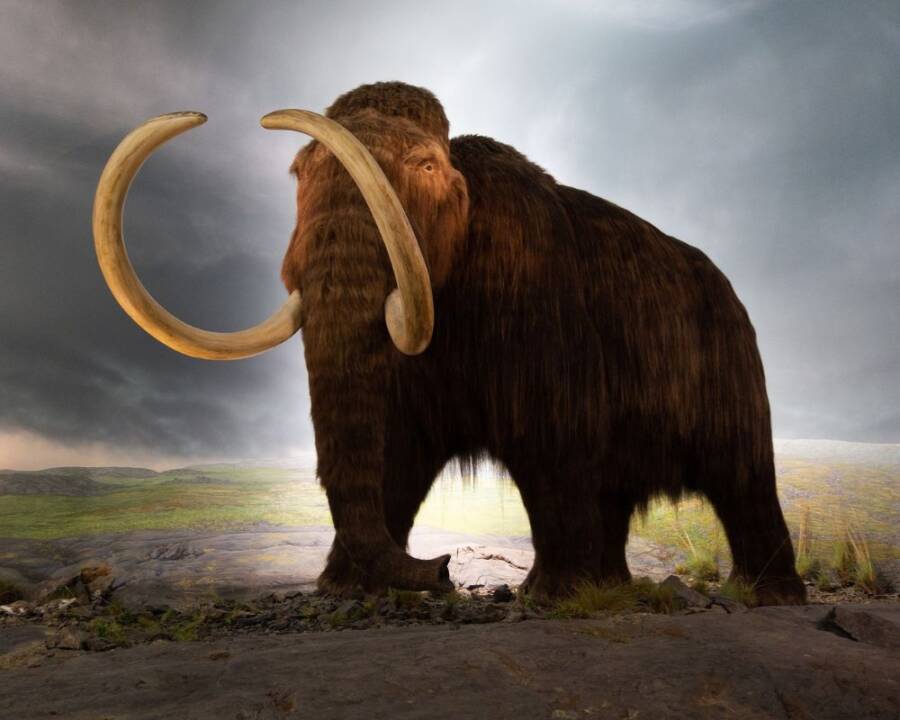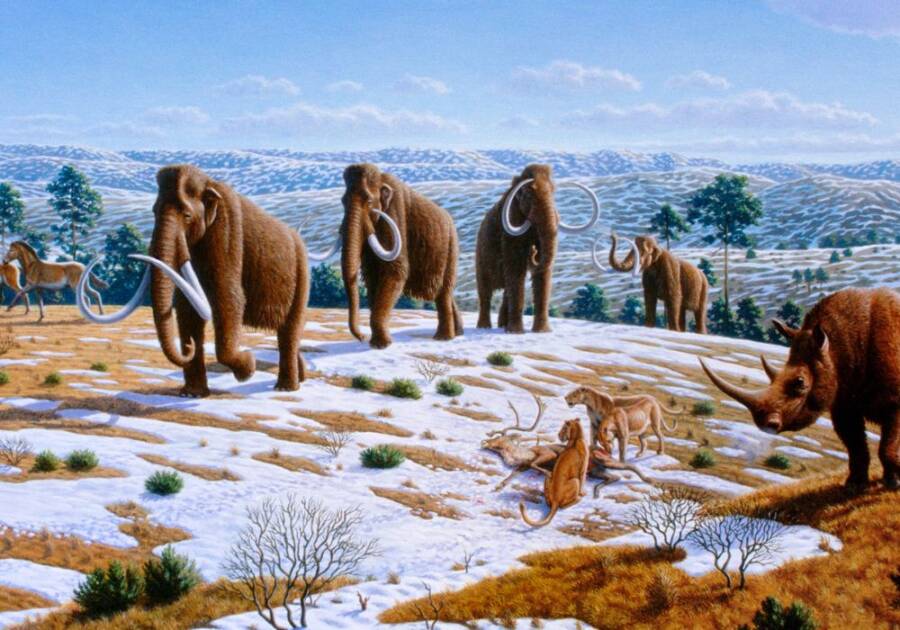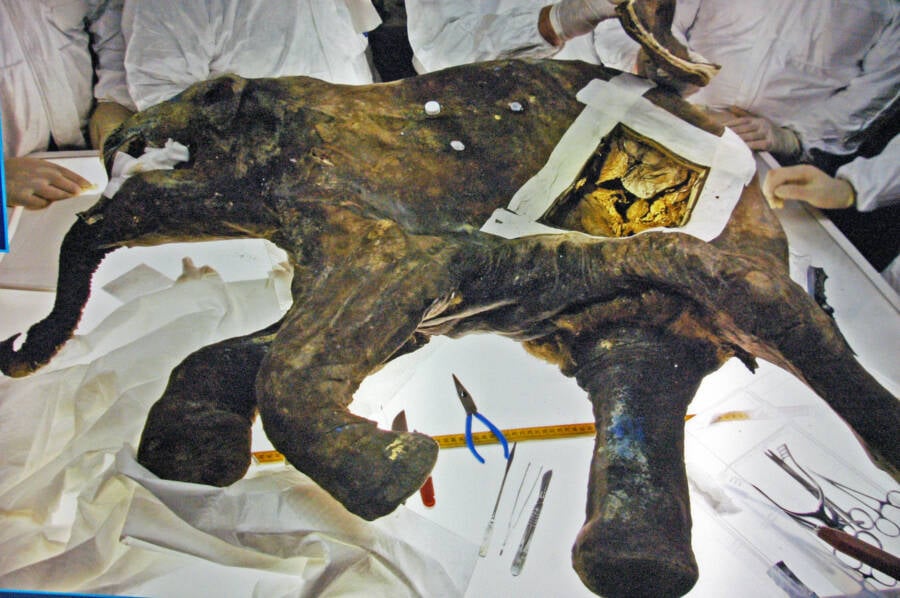Around 10,000 years ago, most woolly mammoths vanished from the Earth — but a small herd survived on Wrangel Island off the coast of Siberia until 1650 B.C.E.

Thomas Quine/FlickrA replica of a woolly mammoth on display at Canada’s Royal Victoria Museum.
Woolly mammoths may seem like prehistoric creatures that died out long before early humans ever built large cities or created a system of writing, but the massive mammals actually lived much more recently than many people realize. So, exactly when did mammoths go extinct?
For the most part, woolly mammoths vanished around 10,000 years ago. However, small herds survived in isolated areas around the globe, such as Wrangel Island off the coast of Siberia. There, they thrived until around 1650 B.C.E.
To put that into perspective, ancient Britons began constructing Stonehenge in 2500 B.C.E., and the Great Pyramid of Giza was built around 2575 B.C.E. That means that Egyptians were keeping records using hieroglyphics and farming settlements were popping up across Britain when woolly mammoths went extinct.
It’s still unclear exactly what killed the last remaining mammoths. Scientists long believed inbreeding was their downfall, but recent research suggests a sudden event led to their demise. What’s more, discoveries beneath the permafrost of the creatures’ former habitat may hold additional answers as to when and why woolly mammoths went extinct.
Why Did Woolly Mammoths Go Extinct?
Woolly mammoths (Mammuthus primigenius) first appeared on Earth around 300,000 years ago, evolving from earlier mammoths, such as the massive steppe mammoth. The species originated in eastern Siberia, eventually spreading west into northern Europe and the British Isles and east across the Bering land bridge into North America.

Mauricio Antón/Wikimedia CommonsWoolly mammoths alongside other Ice Age fauna, like a woolly rhino, cave lions, and reindeer.
Closely related to modern Asian elephants, woolly mammoths were roughly 10 to 12 feet tall and weighed up to eight tons. Their iconic tusks could reach lengths of 15 feet.
The habitat of the woolly mammoth was the steppe tundra, a biome defined by its cold, dry climate and flat, mostly treeless landscape covered in grass and low shrubs. The creatures lived alongside animals like saber-toothed cats, giant ground sloths, bison, dire wolves, and woolly rhinos. They also lived alongside humans.
In fact, humans contributed to the downfall of the mammoths beginning around 15,000 years ago. Overhunting devastated much of the megafauna of North America and Eurasia, and mammoths were sought after for both their meat and their tusks and bones. However, hunting wasn’t the only reason why woolly mammoths went extinct.

Chronicle / Alamy Stock PhotoWhile human hunting wasn’t the main cause of woolly mammoths’ extinction, it was a contributing factor.
The warming climate at the end of the last Ice Age was likely the main cause of the creatures’ extinction. As the environment heated up, the vegetation of the steppe tundra changed rapidly, and mammoths couldn’t adapt quickly enough to survive.
Still, small groups survived in isolated pockets, such as Wrangel Island, a small landmass roughly the size of Delaware about 90 miles off the northern coast of Siberia. There, they lived on for thousands of years — but their days were numbered, too.
When Did Woolly Mammoths Go Extinct?
While most woolly mammoths went extinct 10,000 years ago, the Wrangel Island mammoths continued to thrive. As Love Dalén, an evolutionary geneticist at Stockholm University, told The New York Times in 2024, “Wrangel Island was a golden place to live.”
The mammoths likely walked to Wrangel Island over sheets of ice, but as the climate warmed, the ice melted, stranding them there. Scientists believe the Wrangel Island herd began with fewer than 10 woolly mammoths but ultimately expanded to about 200 creatures.

Boris Solovyev/Wikimedia CommonsWrangel Island, where woolly mammoths lived until just 4,000 years ago.
Over the 6,000 years the mammoths lived on the island, they may have struggled with diseases due to a lack of genetic diversity, but because there were no predators present, they were able to survive anyway.
In a 1995 study published in the journal Radiocarbon, a team of researchers radiocarbon dated woolly mammoth bones, teeth, and tusks collected on Wrangel Island between 1989 and 1991. The data showed that the species existed on the island until around 1650 B.C.E.
So, what exactly happened when woolly mammoths went extinct for good 4,000 years ago?
What Happened To The Wrangel Island Mammoths?
If inbreeding didn’t kill off the last surviving woolly mammoths, what did?
Recent research suggests that a sudden, disastrous event led to the demise of the final mammoths on Wrangel Island. Dr. Dalén suggested to The New York Times that a tundra fire, volcanic eruption, or even a migratory bird carrying an influenza virus may have killed off the species once and for all.
“We’re still left with a number of possible explanations, and we still haven’t been able to narrow it down,” said Dalén.
Dalén expanded on these hypotheses in a statement to Science Daily. “We can now confidently reject the idea that the population was simply too small and that they were doomed to go extinct for genetic reasons,” he said. “This means it was probably just some random event that killed them off, and if that random event hadn’t happened, then we would still have mammoths today.”
Other researchers have proposed their own theories about woolly mammoth extinction, such as the possibility that Wrangel Island mammoths died due to an “icing event.”

Science History Images / Alamy Stock PhotoScientists posing with the remains of a woolly mammoth found in Siberia in 1900. He is believed to have died instantly after falling off a cliff 44,000 years ago.
In 2019, Laura Arppe of the Finnish Museum of Natural History told Newsweek, “Judged from the numbers of radiocarbon dated mammoth bone finds on Wrangel Island, this last island population appears to have vanished rather abruptly. There [are] no signs of a dwindling population size before the extinction. [It’s] kind of like they hit a wall at approximately 4,000 years ago.”
Arppe believes an abnormal amount of rain or snow caused Wrangel Island to become covered in ice, destroying the mammoths’ food supply and leading to their final extinction.
Regardless of how, why, or when woolly mammoths went extinct, modern scientists have hope that they can bring the prehistoric creatures back to life.
The Push For Woolly Mammoth De-Extinction
At present, woolly mammoths are considered a candidate for de-extinction. This is the process of genetically engineering new mammoths from preserved DNA and using Asian elephants as surrogates. Colossal Biosciences and Laboratories boasts its “cold-resistant elephant” with all the biological traits of a woolly mammoth project as a landmark in the field.
Why do scientists want to bring back the woolly mammoth, though?

James St. John/FlickrThis is the most complete mammoth specimen ever found. This female woolly mammoth died in Siberia about 42,000 years ago when she was around one month old.
The mammoth was a key player in protecting the ecosystem. The creatures’ weight and gait helped compact the dirt beneath their feet. When they scraped layers of snow aside in their search for food, they ensured that air reached the soil underneath.
This made for healthier grasslands, which absorbed more carbon. It also ensured that snow melted more slowly, providing a reflective surface to counter the radiation of the Sun. If the decline in large mammals caused grasslands to vanish, then re-introducing similar mammals in the same places could promote grass growth and revive the once highly-productive ecosystems. In addition, resurrecting and studying the woolly mammoth may help save elephants that are currently endangered.
Ethical questions aside, however, de-extincting woolly mammoths would be a large, time-consuming project that could have unintended ecological consequences. However, the desire to bring back long-lost animals is understandable, and mammoths aren’t the only candidates. If de-extinction works, we may be heading into a new scientific era — one that could help restore the planet.
After learning when woolly mammoths went extinct, find out more about other extinct animals from the past. Then, learn about 11 of the most unbelievable prehistoric creatures that once roamed the Earth.





